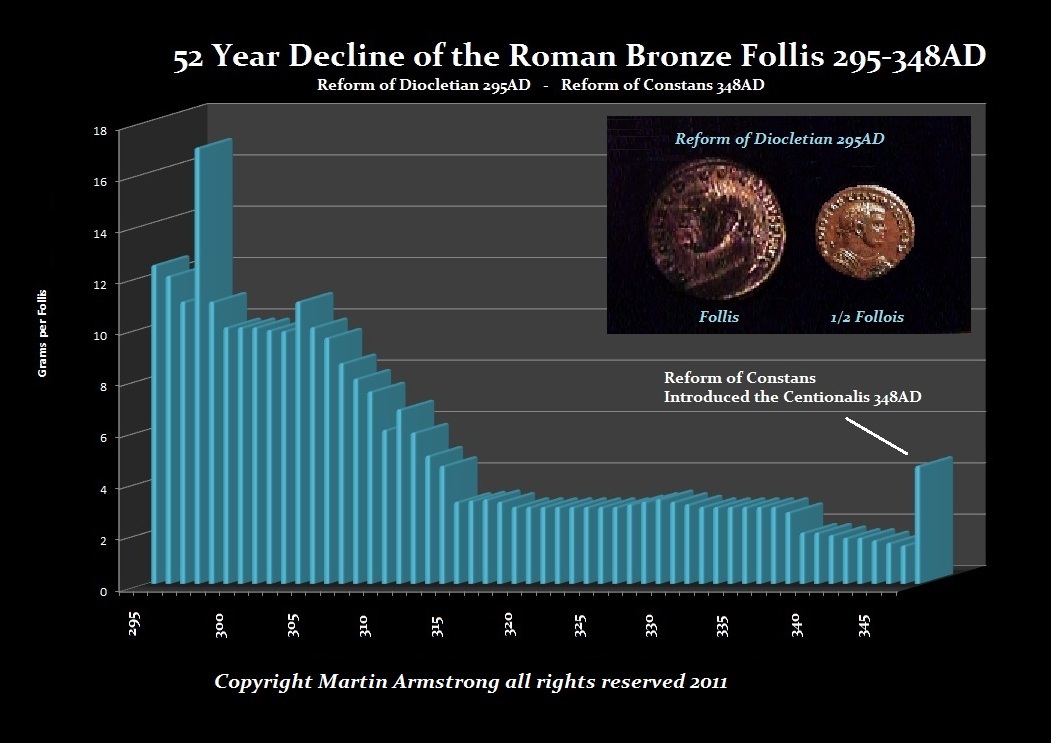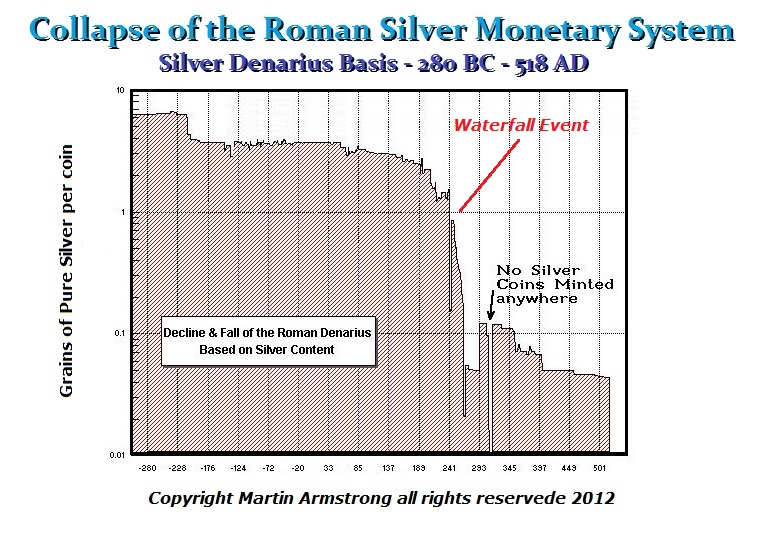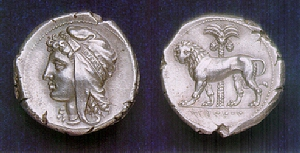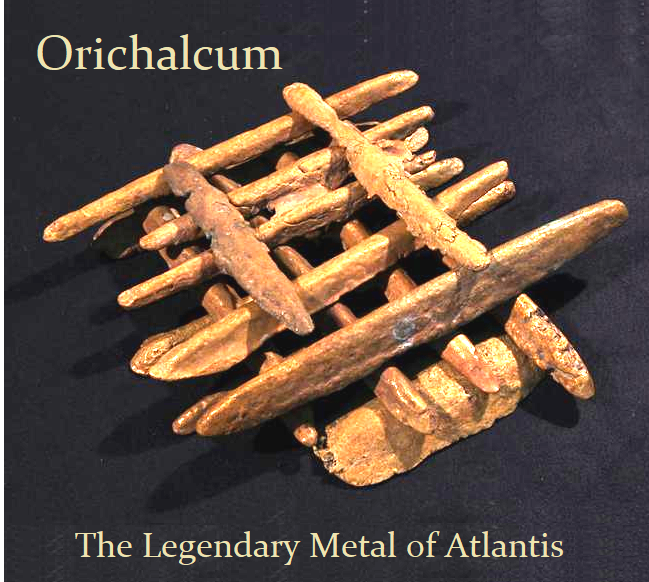QUESTION: Mr Armstrong,
How does the ECM stack up against The Punic Wars which left the victor, Rome,the Mediterranean superpower and on the road to Empire?
Many thanks for sharing your historical knowledge.
JR
ANSWER: When I back tested the Economic Confidence Model, this frequency appeared over and over again throughout history in all cultures. Even the great reforms of Diocletian (284-305AD) saw a 52-year decline in the coinage in weight before another reform took place.
The sharp decline in the Roman monetary system during the 3rd century accelerated once Valerian I (253-260AD) was captured by the Persians. It took just 8.6 years to collapse in silver content from 55% to virtually zero. The overall decline from the peak of the Roman Empire under Marcus Aurelius to the bottom was 86 years. From the start of the post-Depression socialistic/Marxist era that began in 1934, interestingly enough that is the bottom of the current wave in the ECM – 2020.
What caused the total collapse in the Roman Monetary System? Was it inflation or lack of confidence? It was the fact that Valerian was the first Roman Emperor to ever be captured. This sent a shock wave through the empire where people hoarded money, the economy contracted, and that resulted in the government having to debase the money to pay its bills. As always, the CONFIDENCE evaporates FIRST and then the hyper-inflationary outcome results. It has NEVER been the other way around.
Looking back during the Republican era, we see that in 270 BC, the confrontation between Rome and Carthage began and lead to the outbreak of a trade war in 264 BC, known as the First Punic War. Rome succeeded in subjugating Italy in 270 BC when it recaptured Rhegium (southern Italy) from the Mamertines and defeated the Brutians, Lucanians, Calabrians and Samnites. Southern Italy was a trade link for Carthage. The Romans restored the town of Rhegium to its original Greek inhabitants. Carthage actually controlled Sardinia, southern Spain, and Numidia along with Sicily. Carthage inherited their naval strength and experience from their fore-bearers, the Phoenicians, and became a powerful seafaring entity who really clashed with the Greeks for the Mediterranean. Carthage was ruled by an oligarchy of merchants who relied upon mercenaries for its soldiers.
The Sicilian Wars (Greek-Punic Wars) were a series of confrontations between the Carthaginians and the Greek city-states, which at the time were led by Syracuse. They were a contest for control of Sicily and the western Mediterranean between 600 BC and 265 BC. Therefore, the Sicilian Wars were fought on the island of Sicily but did not involve Rome.
After Agathocles of Syracuse sued for peace, Carthage enjoyed a brief and unchallenged period of control over Sicily. However, Carthage’s control of most of Sicily came to an end with the Pyrrhic War. This was the second phase of Pyrrhic War (280–265 BC), which eventually led to the Roman-Punic Wars. Pyrrhus of Epirus arrived in Sicily to rescue the island from Carthaginians but was only partially successful and returned to Italy. Only when Rome became involved in Sicily did the reign of the Carthaginians come to an end in Sicily. Thus, the First Punic War (264–241 BC) began in 264 BC after Pyrrhus retreated from Sicily.
Trade effectively emerged as a major economic means of increasing the national wealth in North Africa. The Punic Wars between Rome and Carthage (known today as the suburb of Tunis, Tunisia) and the ancient center of the Carthaginian Empire are indicative of this lucrative trade based on the acquisition of wealth following the Minoan model. Even after Rome soundly defeated Carthage during the First Punic War (264–241 BC), the city rose again because of trade. The First Punic War (264–241 BC) was a battle to control Sicily and Corsica. To defeat Carthage, the Romans had to create a navy, and finally with a fleet of 200 ships they compelled Carthage to yield.
During the Second Punic War (218 –201 BC), Carthage gained land in Spain and Hannibal led an ambitious campaign to defeat Rome. The Punic Carthaginian military commander renewed the war by invading Italy by land from the north over the Alps. This invasion caused Rome to issue its first gold coins in an effort to convince the rest of Italy to resist Hannibal. These were stated to conform to the Greek monetary standard.
In the end, Rome prevailed and the famous Roman statesman and General, Scipio the Great (236–183 BC) took the war to Carthage. Scipio defeated Hannibal and demanded an indemnity and the surrender of their entire fleet. Coins were issued in the denomination of the Shekel of Northern Africa with his portrait proudly displayed.
Nevertheless, the Carthaginians quickly recovered since their talent was trade. The sheer ability of trade to rebuild the economy was an example to all nations. This created the envy of Rome’s imitative merchant class who could not yet compete in international trade. This envy is what sparked the Third Punic War. Amazingly, the Third Punic War (149–146 BC) was 51.6 years from the defeat in 201 BC. The Second Punic War (218 –201 BC) was 51.6 years from the conquest of Italy in 270 BC.
The timing of the ECM in waves of 51.6 years has existed from ancient times into the present. This has been a very interesting discovery, rather than a theory.



















